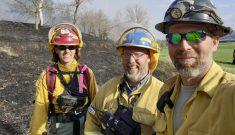There are cultural and political divisions between Canada’s rural and urban populations at the best of times, but the past 12 to 24 months have not been the best of times.
Though the border and Ottawa protests are now over, the fallout from the events has the potential to reinforce divisions with rebar and concrete.
We can fix things, though — if we all calm down.
Read Also

FCC partners with major Toronto innovation hub
A FCC parntership with MaRS Discovery District aims to solve technology problems in food supply chains.
Humans are tribal by nature. We use heuristics, a short-hand, imperfect method that the brain employs for problem solving and making judgements. With this in mind, let’s consider how a person living in an urban or metropolitan area reaches conclusions about the protesters based on the rhetoric, imagery and appearance of the protestors.
Whatever one’s position on organized religion, there is a strong streak of religiosity (specifically Christian) among those protesting. There are too many camouflage-pattern pieces of outdoor apparel to count. Rhetoric railing against a government that was recently democratically elected, largely by non-rural populations, is endemic.
Large-bearded and bellied protestors with Canadianized Braveheart face paint shouted “freedom.” The very nature of the protests’ origin, the trucker vaccine mandate, relates to blue collar jobs that are themselves stereotypically (though incorrectly) associated with rural populations.
On the surface, so much of the protests were seen as just that — a stereotype; a circus established by unsophisticated rustics. This is not uniformly true, of course, but the optics became such that our proverbial Jane and Jack Urban could easily draw unfortunate conclusions.
Now, add truly egregious occurrences — the appearance of fascist iconography, the desecration of war memorials, demands to forcibly change the elected government (Capitol Hill riots, anyone?), and weeks-long harassment of local people and businesses, just to name a few.
The discovery and arrest of a group apparently willing to escalate the situation with an array of firearms is, at the time of this writing anyway, the latest in a string of happenings that, to my mind, has to make the blue sections of our political map much scarier to many people.
Are there genuinely good people involved in events like the protests? Of course there are.
But when a portion of those involved have enough gall — or perverse worldview — to invoke such deplorable imagery and behaviour, everyone gets reduced to the lowest common denominator.
Such distillation happens to the livestock sector every time activist groups release undercover videos of animal abuse, real or imagined, so why would the occurrences on Canada’s borders and within the capital be any different?
The protests were certainly not just a manifestation of rural discontent, and those involved were certainly not all bad folks hellbent on mischief and the imposition of nefarious policies. These are givens, whatever one’s position on the original motivation. But from a public relations perspective, the presence of tractors, truck, and other characteristics more associated with rural life inexorably link its denizens with the movement, at least peripherally.
Cultivating positive communication, relationships, and establishing mutual goals between the farming community and the public is a rewarding but difficult task. One has to wonder — what longer-term impact will the devolution of the protests have on the ag sectors’ credibility with urban Canadians, let alone policy makers elected from urban ridings?
I witnessed a potentially telling example when viewing Raquel Dancho, a Member of Parliament from Manitoba, deliver a speech to the House of Commons at the height of the Ottawa protest.
Her speech, an attempt to explain the hardships of her constituency and why they are relevant to the anger then being expressed outside, took a frustrated and passionate tone after Dancho apparently noticed an opposing MP laughing at her arguments.
It doesn’t matter who the opposing MP was, nor what I think about Dancho’s perspective. What matters is the reaction — the laughter — to her words. It’s a clear example of someone not taking a fellow Canadian seriously in the midst of the most politically divided time in a generation. It represents a breakdown in communication and understanding that must be avoided.
Regardless of where one stands on the protests, mandates, climate — whatever issue has you up in arms — a widespread breakdown in understanding and empathy is and will be disastrous.
Take a breather, everyone
We are all angry right now, though each for our own reasons. The first step is to take a breather and calm down. Continually fighting with a partner rarely results in good outcomes, after all. The same applies in the civic sphere.
After we’ve all relaxed a bit, pay close attention to the true source, or sources, of anger. The answer might be less intuitive than it seems at first glance, particularly given the human tendency to find other peripheral things to be mad at once our blood is hot.
The protests may have begun as an anti-vaccine mandate movement, for example, but they quickly became a series of events focused on nothing in particular. This makes it impossible for non-supporters to track what the group wants, and harder for the group itself to achieve its goals.
Once an issue is identified, do your homework. Do a lot of homework. Consume material in support of, and in contrast to, your perspective on the issue. Consider the context in which the issue is occurring, and watch for assumptions you might be making lest you fall into conspiratorial thinking — something that happens far too often.
Develop an understanding of where other people are coming from. It’s critical in the democratic process, and besides, it actually helps make you more effective at arguing your own perspective.
Talk to your MP, whether you like them or not. Talk to colleagues, whether you like them or not. Rebuild and continue fostering community relationships with those in and outside rural cultures.
Show them camouflage clothes are not scary. Try your utmost to be respectful and calm — even when the other party is being unreasonable. You will not succeed all the time (none of us do), but we have got to try, at least more than we are now.
This is a “both sides” argument. Whatever your political orientation, put a face to what is now, more than ever, an unknowable other.
Many of us have lost friends because of a lack of understanding and critical thinking. Let’s all give our heads a shake and stop this madness.













